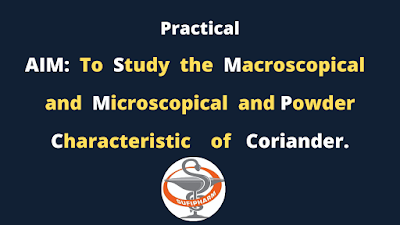CORIANDER
Synonyms
: Coriander
fruit, Dhania (Hindi)
Biological
Source : Coriander
consists of dried ripe
fruits of Coriandrum sativum,
belonging to family Umbelliferae.
Macroscopy
:
The fruit is a cremocarp, subspherical in shape,
Yellowish brown in colour. The size of the fruit is 3 to 5 mm in diameter, with
aromatic odour, and spicy, aromatic taste.
Microscopy
:
The transverse
section of coriander
shows the presence
of a dorsal
surface and a commissural
surface. The dorsal
surface consists of
two vittae and
a carpophore. The dorsal
surface has five primary ridges
and four secondary ridges. The
epicarp consists of a single row of small thick-walled cells with
calcium oxalate crystals. The mesocarp
has an outer
loosely arranged tangentially
elongated parenchyma cells and the middle layer consisting of
sclerenchyma.
The middle layer
is again divided
into; the outer
region of sclerenchyma
is represented by longitudinally running
fibres, whereas the
inner region has tangentionally running
fibres. The vascular
bundles are present
below the primary ridges. The
inner layer has
polygonal, irregularly arranged
parenchyma cells. The endocarp has the parquetry arrangement.
In the testa it has single-layered, yellowish cells, and
the endosperm is
thick, polygonal, colourless
parenchyma with fixed
oil and aleurone grains.
"Mericarps
usually coherent; cremocarp
nearly globular, from
3 to 5
mm. in diameter; externally
light brown or
rose colored; summit
with 5 calyx
teeth and a short
stylopodium, each mericarp
with 5 prominent,
straight, longitudinal, primary ribs
and 4 indistinct,
undulate secondary ribs;
mericarps easily separated,
deeply concave on the
inner or commissural
surface and showing
in transverse section
2 vittae (oil tubes) on the inner surface of each.
Under the microscope, sections of Coriander show an epidermis of small cells with thick walls; a layer of several rows of thin-walled more or less collapsed parenchyma separated from a broad zone of strongly lignified, sclerenchymatous fibers which extend as a continuous ring in the mesocarp of each of the mericarps; 2 or 3 layers of large, tangentially elongated, thin-walled parenchyma cells, frequently with numerous large lysigenous intercellular spaces; inner epidermis of large tabular cells, the inner yellowish walls being considerably thickened and closely coherent to the brownish cells of the seed-coat; commissural surface with 2 large, elliptical vittae; the cells of the pericarp separated from the seed-coat and forming a large elliptical cavity; endosperm distinctly reniform in outline and consisting of tabular or polygonal thick-walled cells containing numerous large aleurone grains each with a rosette aggregate or prism of calcium oxalate.
Powder
Microscopy :
Coriander
powder is light
brown to brown
in colour with
aromatic odour and characteristic aromatic taste. It is
characterized microscopically by:
i.
Numerous irregular fragments
of endosperm cells
containing globules of
fixed oils and aleurone
grains. Calcium oxalate
crystals are numerous,
from 0.003 to
0.01 mm. in diameter, mostly in rosette aggregates.
ii.
Fragments of
endocarp cells associated
with hexagonal sclerenchyma
of the innermost layer of
mesocarp.
iii.
Sclerenchymatous fibers
irregularly curved, having
thick, yellowish, lignified
walls and having numerous simple pores and numerous globules of fixed
oil.
iv.
Fragments of characteristic irregularly
curved yellowish pitted lignified fusiform fibres of the mesocarp.
v.
Fragments of parenchymatous cells of the
mesocarp without reticulate thickening.
vi.
Very few fragments showing pieces of
yellowish brown vittae.
vii. Hairs and starch granules are completely absent.
1. A group of sclereids from the mesocarp with adjacent unlignified parenchyma.
2. Branching
vittae (Shows in outline only) and underlying endocarp in surface view.
3. Covering
trichomes.
4. Part
of a group of fibro-vascular tissue.
5. Epicarp
in surface view showing stomata and striated cuticle.
6. Part of
two vittae showing transverse septa and
part of the underlying
endocarp in surface view.
7. Testa
in surface view.
8. Endosperm
containing microspheroidal crystals of calcium oxalate.
Chemical
Constituents :
Coriander consist of about 1% of volatile oil the chief volatile components are D-(+)- linalool (coriandrol), along with other constituents like, borneol, p-cymene, camphor, geraniol, limonene, and alpha-pinenes. The fruits also contain fatty oil and hydroxycoumarins. The fatty oils include acids of petroselic acid, oleic acid, linolenic acid, whereas the hydroxycoumarins include the umbelliferone and scopoletine.
Uses
:
Coriander
is used as
Aromatic, carminative, stimulant,
alterative, antispasmodic,
diaphoretic and flavouring
agent. It is
also used as
refrigerant, tonic, appetizer, diuretic, aphrodisiac,
and stomachic. Coriander
can be applied
externally for rheumatism and
painful joints. The infusion of decoction of dried fruit of cardamom is
useful for the
treatment of sore-throat,
indigestion, vomiting, flatulence,
and other intestinal disorders.
Coriander
is a rather
feeble aromatic. It
is almost exclusively
employed in combination with
other medicines, either
to cover their
taste, to render them acceptable to the stomach, or to correct
their griping qualities.
Thank You for visit.............








1 Comments
Thanks for the information. I really like the way you express complex topics in lucid way. It really helps me understand it much better way. coriander powder
ReplyDelete